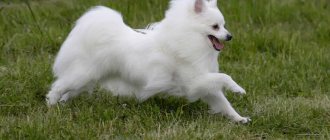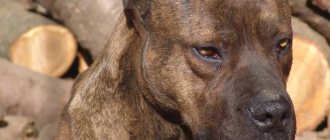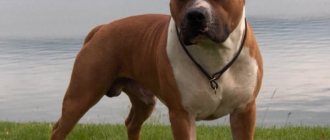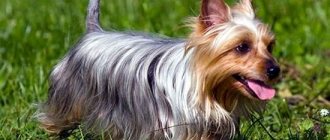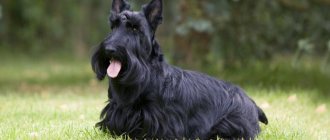History of Dalmatians
The breed is considered very ancient, so its exact origin remains a mystery. Based on historical facts, researchers put forward many versions, but none have been confirmed.
Images of spotted dogs bearing a striking resemblance to modern Dalmatians are often found among ancient artifacts in Mediterranean countries, India and Egypt. These are figurines, drawings, reliefs dating back to 4,000-1,100 BC. e.
Animals are mentioned with descriptions of the breed in the works of several philosophers from the first millennium BC. e. Surprisingly, starting from the 1st century, information about Dalmatians has not been found in any of the historical sources.
Origin of the name of the breed
More recent evidence is found in medieval Croatia (province of Dalmatia on the Balkan Peninsula). Images of Dalmatians, starting from the 13th century AD. e., are present on ancient ceramics, coats of arms of cities and nobility, paintings. There are also several descriptions of a white individual covered with black dots, dating back to the 13th – 18th centuries.
A document dating back to 1374 even mentions a nursery in Dalmatia that housed 500 Canis Dalmaticus. This means that the breed could get its name from the name of this historical region.
Another version of the origin is that for the first time in Europe, a resident of Serbia, Yuri Dalmatin, began breeding the animal at the end of the 16th century. He received as a gift several individuals brought from Bohemia.
In 2010, the version about the Croatian origin of dogs was officially adopted.
Video about the breed
The Dalmatian is a versatile companion dog. She is truly adored all over the world. When you mention the name of the breed, scenes from everyone's favorite family movie immediately come to mind. Its screenwriters did a masterful job of describing the dog’s character, demonstrating his intelligence and main advantages.
Everyone knows this animal as a kind dog with black and white spots. She will not go unnoticed anywhere. What is the secret of her popularity? Let's figure it out.
Description and breed standards
A healthy Dalmatian has developed and strong muscles, is hardy and active. There is no clumsiness or sluggishness in the dog’s movements. The dog's leg joints have a special angle of inclination and correct balance, due to which when running the Dalmatian makes powerful and at the same time smooth jerks and is able to cover distances of many kilometers.
Color
There are no two identically colored individuals: some are almost white, with several small dark specks, and others are light with specks barely visible through the black merging spots. The dots on the fur of Dalmatians can be large or small, evenly scattered over the body or connected into a continuous dark surface.
According to the breed standard, two types of dog colors are allowed:
- black and white;
- brown-white.
The spots are round in shape, evenly pigmented, 2-3 cm in diameter. The location is uniform, but on the paws, head and tail of the Dalmatian they are smaller and less common.
Weight and size
Sexual dimorphism is clearly expressed. Clear standards for Dalmatian weight and height have been officially defined:
- Male weight – 27-32 kg, height at withers 56-61 cm.
- The bitch looks more graceful and thinner. Adult size: 54-59 cm, weight – 24-29 kg.
Dogs can weigh significantly more than the upper limit of the standard. This is acceptable if the Dalmatians have the correct proportions.
Wool
Dalmatians are a short-haired breed. Dogs' coat is thick, dense and shiny, smooth and even to the touch. There is no undercoat.
Breed physique
The body proportions of a Dalmatian are clearly regulated by standards:
- The dog's head is elongated and has the shape of an even wedge. The forehead is wide, slightly rounded, with a groove in the middle. Cheekbones are pronounced. The lips do not sag, they are dry, there should be rich pigmentation along the outermost line. The skin is taut, without folds. The bridge of the nose is straight. The length of the muzzle and the rest of the Dalmatian skull are the same.
- The dog's ears are in the shape of triangles, wide at the base, with rounded ends, lowered towards the head when at rest, and turned forward when aggressive. The cartilage is thin and soft.
- Dalmatians' teeth are white, even, the bite is tight, without gaps.
- The dog's nose is large and wide, colored to match the spots on the body, and the nostrils are open.
- The dog's eyes are oval-shaped and shallow-set. The eyelids do not sag and have an edging that matches the spots. The iris is brown (light or dark).
- The neck is long, without dewlap, with a smooth bend. Widens towards the shoulders, narrows towards the head.
- The body of the Dalmatian is streamlined, slightly rounded. The withers are raised. The groin is tightened. The croup has a slight slope. The dog's chest is of medium width, deep, the lower part is at the level of the elbows. The ribs are proportional and rounded.
- The tail extends to the hocks, thicker at the base and thinner at the tip. It does not twist, but only rises slightly while walking. Straight (let's say a small crease by a third).
- Dalmatians' limbs look perfectly straight. The elbows are pressed to the sternum, the muscles appear. The toes are not splayed, the nails are white or pigmented.
The ratio of the proportions of the length and height of the body of the Dalmatian is 10/9.
Which dogs are culled?
A fairly large number of animals (about 13%) have deviations from accepted breed standards, due to which they are not allowed to participate in exhibitions and breeding:
- Dalmatian puppies are not born white, but with congenital spots. A specialist can identify them even in an adult: they are large in size and solid black in color, without light hairs. Wool is usually softer and silkier to the touch.
- In a few individuals, the spots become gray or bronze in color (yellow, red or light brown) with age. Only Dalmatians with black and brown spots can be registered.
- Blue eye color. This defect in a dog is detected on days 12-16.
- Not colored nose (more than 5%) or eyelid rims. The disorder occurs in many dogs, and if it does not disappear with age, he will be disqualified.
- Tricolor Dalmatians.
- Almond-shaped eyes, a thorn in the dog.
- Malocclusion in a dog.
- The dog's character should not be too timid or aggressive.
Expert opinion
Anna Abramenko
An avid dog lover. Experience in veterinary medicine since 2009.
Ask a Question
Such animals are not suitable for exhibition or breeding, but will make excellent pets.
What colors of Dalmatians are recognized by breed standards?
When we talk about Dalmatians, we think of dogs with contrasting monochrome black and white colors. Symmetrical black spots on a pure white background are one of the breed's coat colors recognized by international standards. This is exactly what the puppies from the legendary cartoon “101 Dalmatians” looked like; this is the kind of fur coat that the villainess Cruella De Vil wanted to sew for herself.
But this is not the only color allowed by breed standards. The second one is brown-spotted. In our country, this color is not very common, but abroad such dogs are owned more often than black and white ones. Western breeders specifically select white-brown pairs to produce puppies of this color. Dalmatians with brown spots are allowed for breeding and exhibition. It differs from the black and white variety in that the size of the spots on the Dalmatian with brown spots is smaller.
Brown Dalmatians look very noble and sophisticated. They have a less contrasting coat, a softer color of spots - this invariably attracts the attention of judges at exhibitions and passers-by on the streets. To get beautiful offspring with brown spots, the parents must have well-defined pigmentation. If this condition is neglected, offspring may be born with weakened pigmentation. This can lead to breed defects.
Requirements for spots on Dalmatians:
- The main color is pure white without interspersed colored hairs.
- The spots have a clearly defined shape.
- Symmetrical arrangement throughout the dog's body.
- The preferred spot size is 2-3 cm.
- The size of the spots on the limbs and head should be slightly smaller than on the rest of the body.
- Solid spots and areas of darkened fur are not allowed.
- There should be no white hairs on the surface of the spots.
- The tail should be spotted, the size of the spots on the tail is smaller than on the body.
- The spots on the ears should be especially noticeable, but they should not be a uniform dark color.
- The color of the spots on one dog should be the same. Tricolor in any combination (white-black-brown, white-brown-red, white-brown-lemon, white-brown-orange) is not allowed.
Important: a congenital continuous spot is a disqualifying defect.
Purpose of the breed
Over the centuries-old history of the existence of Dalmatians, people have found different uses for them. And four-legged friends have always justified the trust placed in them.
In the 18th century in England, Dalmatians received the nickname “coach dog”. Several Dalmatians accompanied the carriages, clearing the road and urging the horses on. The aristocratic and elegant appearance made the animal incredibly popular among the nobility. Numerous nurseries were created in the country and the colonies, which almost led to the degeneration of the Dalmatian breed. Gradually, carriages were replaced by cars, and the need for a canine escort disappeared.
The breed has been widespread in America since 1800. Dalmatians are known to have been used as fire sirens. A pack of barking dogs cleared the streets of passers-by in front of a cart on its way to a call.
Dalmatians are highly trainable and distinguished by their artistry, which is why in the 18th and 19th centuries they were participants in circus performances.
The British attracted smart and obedient animals to serve in the police, used dogs for hunting, as shepherds, and security guards.
Character
Dalmatians are distinguished by active social behavior. Dogs are ready to take part in all family affairs, they are cheerful and cheerful. Dogs are incredibly loyal to their owner: the highest reward for an animal is to earn praise and approval. Dalmatians love children, but due to their large size they can accidentally cause harm (push, knock down, pull on the leash). The dog does not show excessive aggression towards strangers and behaves restrained and wary.
Expert opinion
Anna Abramenko
An avid dog lover. Experience in veterinary medicine since 2009.
Ask a Question
The breed does not allow a rude and familiar attitude; Dalmatians are somewhat vindictive. The owner must immediately let the pet know who is boss in the house - male dogs tend to dominate.
To maintain the dog's vitality, normal physical activity and long walks are important. Dalmatians rarely speak, but they do an excellent job as guards.
Breeding
The first heat of a female Dalmatian occurs at 6-8 months. But the dog is lagging behind in growth and development, so mating must be waited until 1.5-2 years. Estrus occurs twice a year, lasting 3-4 weeks. Mating takes place in the male dog's territory.
Pregnancy in the breed lasts 61-65 days. The owner must carefully monitor the bitch and carefully organize the upcoming birth of the offspring (prepare the place, accustom it to it). Usually, Dalmatians give birth easily, but complications arise, including the need for a caesarean section.
A Dalmatian litter usually produces 6-10 snow-white puppies (the record is 18). Barely visible dark spots are visible in places where there is short hair: on the stomach, paw pads, nose, around the mouth. A few days later, the first dark spots appear all over the dog’s skin, which become brighter every day. By 3-4 months, the color of babies is completely formed.
Expert opinion
Anna Abramenko
An avid dog lover. Experience in veterinary medicine since 2009.
Ask a Question
Lack of mating will adversely affect the health of a Dalmatian of either sex. It is better to sterilize a non-breeding bitch.
How to check your pet's health yourself
It is necessary, among other things, to determine whether the animal has a hernia. This procedure is easily performed with the pet resting on its hind legs in a standing position. A hernia can be felt as a bulge in the belly button. It is worth paying attention to the movements of the little Dalmatian: are there any X-shaped hind limbs, club feet, what is the stance of the paws. It is possible that such symptoms will disappear in the future, but one should not hope for this.
It is easier to test your puppy's hearing when he is sleeping. He should immediately wake up from the sudden noise. And if we are talking about a awake puppy, then his reaction will be in the form of pressing his ears or turning his head.
A fault is the color of a pale yellow, peach or lemon shade, the addition of a third color. However, there are no identically colored Dalmatians. A dog's pattern is as individual and unique as a person's fingerprints.
Look at how the eyelids are rimmed. If an adult has a border gap of more than 3 mm, it is discarded. In a 1.5-month-old puppy, this gap should be alarming, in particular if the pigmentation of the coat and the tip of the nose is normal.
Note. At 3 weeks, it is possible to identify a puppy whose nose and eyelid edging are staining more slowly than others (non-staining of 5% or less of the area of the tip of the nose and a tear of the eyelid border of 5 mm or less is not considered a disqualifying defect). However, if such a defect does not improve with age, the dog can be culled.
The entire tip of the nose should be pigmented. So, in Dalmatians with brown spots, the lobe is brown, if there are black spots, the lobe is the same. It is worth considering: the pigmentation of brown puppies develops somewhat more slowly.
By the way, Dalmatian puppies are born without spots and white. At approximately 1.5-2 months, the color completes its formation, but individual spots can appear within 6 months from birth. Over time, nearby spots can merge and grow.
At 2 months of age, the Dalmatian begins to develop character traits. It is easy to notice whether the puppy is active or calm, with what desire he participates in the game or whether laziness prevails.
Education and training
Even a beginner with no training experience can raise a Dalmatian. Animals are willing to make contact and easily absorb knowledge. Once learned, the dog will remember commands forever.
By 4 months, the Dalmatian should be able to walk on a leash, respond to the owner’s call, and learn a nickname. From 5-6 months. It's time to start training your dog. It will be much easier for a child to absorb knowledge if he has interest and incentive.
Effectively engage in groups - Dalmatians are able to imitate. Thanks to ingenuity and a good memory, the pet will be able to master the training course and gradually learn to perform complex tricks.
Expert opinion
Anna Abramenko
An avid dog lover. Experience in veterinary medicine since 2009.
Ask a Question
Dalmatians cannot be kept in an enclosure or on a chain (they can be walked on a leash). The breed gets along well with other domestic animals; friction arises only between two dominant males in a small area.
Care and maintenance
Dalmatians are successfully kept in apartments and private houses, despite their impressive size. The dog easily moves in space without destroying furniture.
Seasonal shedding is not typical for the dog, so every 1-2 days throughout the life of the Dalmatian, the fur should be combed with a soft brush. The dog's skin should be regularly examined for inflammation and parasites.
Your dog's ears require frequent inspection. The norm is a small amount of light-colored sulfur. If there is an odor, redness, or excessive discharge, your pet should be shown to a veterinarian.
From an early age, dogs begin to have their nails trimmed, gums treated, and tartar removed.
The pet will have to be bathed frequently - any minor dirt will be visible on the white background. But it is recommended to wash your dog with special shampoos no more than 2-3 times a year. Dalmatian skin is prone to irritation and allergies, so hygiene products are selected especially carefully.
Nutrition
When purchasing an animal, the owners must find out in the nursery the specifics: what the baby was fed, and whether the dog has any food allergies. The first food for a Dalmatian in a new home can be high-quality dry food. They are nutritious, hypoallergenic and completely safe.
As dogs grow, homemade food is introduced. Dry food can be gradually eliminated. If they are left in the dog’s diet, then they are selected according to age.
These animals eat very quickly and are prone to overeating, which usually leads to obesity in Dalmatians. It is recommended to feed young dogs 3-4 times a day in small portions, adult dogs - 2. Depending on the size and level of activity, the daily food intake for an older pet is 3-6 glasses.
It is useful to include in the breed's diet:
- lean meats;
- sea fish;
- vegetables (carrots, cabbage, cucumbers, zucchini, etc.);
- cereals (oatmeal, rice, buckwheat);
- low-fat cottage cheese.
Periodically, the dog must be given mineral supplements and vitamins. Your Dalmatian should always have clean water in his cup.
Expert opinion
Anna Abramenko
An avid dog lover. Experience in veterinary medicine since 2009.
Ask a Question
Errors in a dog’s diet will lead to dangerous diseases. The maximum fat content in the feed is 10% and protein – 22%.
Breed standard
Most experts classify the breed as a large breed. However, in our opinion, this classification is not entirely correct. The Dalmatian dog is much smaller and lower than, for example, the Caucasian Shepherd or Cane Corso. Therefore, objectively, it should be classified as a medium breed.
This dog is fast, resilient and energetic. It quickly picks up speed thanks to its long, wide-set legs with soft pads. Their grip on the ground is good. Despite their softness, the pads practically do not slip on the surface. The animal's physique is slightly lean and muscular.
The Dalmatian in the photo is elegant and a little self-confident. Despite the simplicity of his character, there is something aristocratic in his gait. All parts of the dog's body are in good harmony with each other. She has a muscular long neck, a sunken, tucked belly, and the withers are practically not pronounced.
The tail is thin, slightly thickened at the base. When the animal is calm, its tail hangs, but when excited, it rises parallel to the ground. By the way, do you know how to determine the mood of a family dog? If it is good, he will wag his tail to the right, but if it is bad, he will wag his tail to the left.
The Dalmatian's head is medium in size, becoming slightly thinner toward the muzzle. His mouth is small, his lips are dry, there is no drooling. The ears are large and hang down to the sides. The eyes are oval and most often have a black iris. The nose is also large and dark. The body weight of an adult male is 30-33 kg, and that of a female is 24-28 kg. The height at the withers of the former is up to 60 cm, and the latter – up to 56 cm. In both cases, the standard allows for a slight error.
The dog's fur is short and two-colored. Everyone knows him as a cute spotted animal, a hero from a famous film. According to the standard, the white body of a Dalmatian should have black spots of different diameters.
Most of the breed are black and white, but others are brown and white. Yes, there are only 2 types of such dogs. The former have a dark nose and black eyes. However, the standard allows for a blue iris color.
But such individuals are born extremely rarely. It is interesting that blue-eyed black and white Dalmatians can be shown at an exhibition only in America, but in other countries of the world they are considered low-breed.
In the second, the nose, like the spots, is brown. Several variations of shades of this color are allowed: melted chocolate, nut, red-yellow, etc. According to the standard, spots of each of these two types of dogs should be all over their body, even on the tail and face.
Health and treatment
Dalmatians have good health. Proper care and a nutritious diet guarantee that your dog will not develop chronic pathologies as he ages. Most often, Dalmatians suffer from the following ailments:
- Urolithiasis and other kidney problems. Although dogs can get them at any age, it is a non-genetic predisposition. Problems arise with an incorrect diet. Signs: pain in the lower back (the dog will not allow itself to be petted, picked up, shaken or touched by this part of the body), difficulty urinating, it is painful for the pet to run, jump, lie down and get up. Prevention – drinking plenty of fluids and normal activity. Self-medication is excluded.
- Pyoderma is a skin inflammation. An abscess appears on the affected area, and the dog’s hair falls out. Factors: stress, decreased dog immunity.
- Atopic dermatitis. The defect is genetic and manifests itself as skin irritation. Causes: dog allergies to insect bites, grooming products, food.
- Demodicosis is an acute disease caused by ticks. The dogs' hair suddenly falls out, seals and itching form on the skin. Easily treatable.
- Eye diseases in dogs (cataracts, retinal atrophy, etc.).
- Hip dysplasia.
The weaknesses of Dalmatians are their kidneys and skin, but there are known cases of their death from heart disease and cancer. Proper care, scheduled visits to the veterinarian and timely treatment will help avoid complications.
Rules for choosing puppies
Future champions begin to be selected from 2 months of age. During this period, most compliance with breed standards appears. The closer the dog is to ideal parameters, the more expensive it will cost. However, due to the high demand for the breed, the amateur risks purchasing a second-rate animal at an inflated price.
Expert opinion
Anna Abramenko
An avid dog lover. Experience in veterinary medicine since 2009.
Ask a Question
When purchasing a Dalmatian, it is important to look at the pedigrees of both parents. The baby himself should be considered based on external signs and behavior. A healthy dog looks slightly well-fed, active, sociable and non-aggressive.
How much do they sell a Dalmatian puppy for?
The cost may vary according to different categories. The price of a small Dalmatian is mainly influenced by its origin. If the pet has a KCY-FCI document, a veterinary passport, and has been vaccinated, the puppy will cost from 20 to 50 thousand rubles:
- the cost in Moscow fluctuates around 20-50 thousand rubles;
- approximate prices in St. Petersburg - from 18 to 45 thousand rubles;
- a Dalmatian in Rostov-on-Don will cost from 13 to 30 thousand rubles;
- in Belarus you can buy a Dalmatian puppy for 15-25 thousand rubles;
- a similar price tag in Ukraine – from 12 to 30 thousand rubles.
You can buy a puppy without documents much cheaper, but before buying you should ask yourself the question: who are the parents, where is the pet from, how was it kept? It is possible that this is not a purebred puppy, but a pet with diseases or other disabilities. Therefore, according to an advertisement in a newspaper or on the Internet, for example, on Avito, it is quite possible to find a Dalmatian puppy for around 4-8 thousand rubles, regardless of the region where you live.
Note. Based on the breeding status of the RKF, puppies of this breed are allowed to be sold after 45 days of life. This period is the beginning of socialization, since puppies from this time are capable of independent living in a new environment.
The cost of a Dalmatian and where to buy it
By purchasing a pet from unreliable sellers, a person runs the risk of getting a stunted, sick and not purebred baby. Therefore, you should only buy a Dalmatian from a kennel or from a reputable dog breeder. Recognized breeders are necessarily members of the national dog breeding federation and specialize in breeding the breed.
The cost of a real Dalmatian in Russia varies between 13-50 thousand rubles. This depends on compliance with breed and regional standards. Private breeders and nurseries offer buyers both expensive exhibition specimens and cheap options with imperfect spots. The owner must have a passport for the animal with vaccination records.
To be guaranteed to purchase a champion, you need to buy an adult with experience in competitions and titles.
Expert opinion
Anna Abramenko
An avid dog lover. Experience in veterinary medicine since 2009.
Ask a Question
About 5% of Dalmatians are born deaf. Therefore, when purchasing, it is worth checking the animal’s hearing. Everything will become clear based on the dog’s reaction to a sharp loud sound, for example, clapping his hands. Individual Dalmatians who are deaf in one ear (there are no more than 14%) are not considered defective and do not differ from those with normal hearing. A defect in a dog can only be detected using a device. Such animals receive a pedigree, but are not allowed for breeding.
Possible options
It turns out that the Dalmatian is only “white and black”? No, there are other colors of spots:
Brown
Sometimes in a litter there may be a puppy with brown spots on a white “fur coat”. Such individuals are not classified as defective, since the brown color of the spots is not a deviation from the norm. According to the standards, the markings of such dogs should be a rich brown color. The eyelids and nose should be painted in the same tone.
Interesting! In order for a puppy with brown spots to be born in a litter, both parents must have the recessive gene.
Redheads
Even less often than puppies with brown spots, babies with red-golden markings are born. But if brown and black shades fit into the standards, variations of red, fawn, peach and lemon yellow are considered defective. Such males and females are not allowed for further breeding.
Important! Some unscrupulous breeders who have become owners of such unusual dogs try to sell them at three prices. To gullible buyers who do not understand the characteristics of the breed, they present such puppies as very rare and unique.
Other
Dalmatians with gray, grey-blue and blue spots on their coats are also considered to be rejected. Puppies with brindle, leopard and tricolor coat colors are also considered substandard. It is the presence of three shades in the color of an animal that is most difficult to identify. Markings of a different color usually appear when the puppy is 2-3 months old, at which time they usually live with their new owners.
Important! It is impossible to meet a Dalmatian with brown and black fur and white spots. If you are offered to purchase such a puppy, then most likely it is either a mixed breed or has nothing to do with the Dalmatian breed.
People who do not intend to take their pet to exhibitions and competitions need not pay attention to the fact that the puppy rejected by the breeder has spots of other shades in its color. This feature does not affect life expectancy, health, character and other characteristics.
Similar articles
Advantages and disadvantages of the breed
When choosing a pet, you need to study the pros and cons of each breed. Positive aspects of Dalmatians:
- dogs are distinguished by their intelligence and willingness to make contact;
- dogs are devoted to their owner;
- animals are good with children.
Dalmatians also have a lot of disadvantages:
- the dog has continuous molting;
- the dog needs to constantly expend energy;
- Raising a dog at the initial stage will require a lot of time and effort.
During puppyhood, the dog needs to learn several basic commands and be able to direct energy in the right direction. The dog lends itself well to further training at any stage.
How to choose a puppy
It is recommended to purchase a Dalmatian at the age of 1 – 2 months, since during this period the future character and appearance of the dog is already determined. It is better to buy from a trusted nursery.
Male Dalmatian puppies are in high demand. However, before buying a male dog, you should soberly assess your strengths and capabilities: raising a dog will require a lot of physical activity and time. A large male dog, not properly trained, if left alone, can destroy the entire house. Dalmatian females have a softer and more flexible character.
About 10% of puppies from each litter are born deaf. Therefore, it is necessary to check the puppy for hearing problems before purchasing.
If you are buying not a small puppy, but a teenager, you need to be prepared for the fact that he has already formed his own character, to which you will have to find an approach.
The price of Dalmatian puppies depends on the purity of the pedigree. A puppy from ordinary parents will cost about 400 – 500 dollars; one suitable for participation in exhibitions will cost up to 1000 dollars. If the parents were champions, the cost of the puppy will be even higher.
The Dalmatian is a kind, cheerful and energetic dog. It is not suitable for people who lead a passive lifestyle and are not ready for frequent jogging and walking. To prevent a naturally kind and gentle character from becoming harmful, the Dalmatian needs to devote a lot of time, communicate with him, and educate him. For a caring owner, the animal will become an excellent companion and loyal friend.
Interesting Facts
Dalmatians are amazing and unusual animals. Interesting facts about dogs:
- dogs have an expressive voice: they make sounds of different timbres, showing the owner’s mood and needs;
- Dalmatians can smile and are considered the best companions;
- dogs love to swim and dive without fear;
- in the USA there is a nursery where dwarf Dalmatians are bred (the breed does not officially exist; professionals believe that mini-dogs are bred from inferior specimens that are stunted);
- Dalmatians love warmth and can easily tolerate heat, but even at -20 they feel great and do not freeze (at low temperatures, it is recommended to wear overalls for long walks).
Living under the same roof with a Dalmatian, the owners will constantly have to learn a lot of new things about their pet.
It is not known for sure, but it is believed that the Dalmatian was created by crossing a marbled Great Dane with an Istrian pointer.
Reviews
People have conflicting opinions about keeping Dalmatians as pets:
- “This is not just a pet, but a real friend and companion! Sociable, active dog, takes part in everything. The dog is very smart and understands a lot. True, at least minimal training is necessary for him to become well-mannered, and then such a friend will not be worth anything!”
- “My Dalmatian has an easy-going character. Since puppyhood, the dog has not behaved like a bully and now has a balanced disposition, understands commands perfectly, and is very patient with children. The dog is active, but in moderation, and does not destroy the apartment. If you decide to get a Dalmatian, this is a great choice! The breed has a drawback in the form of endless shedding, but if you are not lazy and brush the dog more often, then there will be much less hair around the house.”
- “Dalmatians, of course, are beautiful and intelligent animals, but I don’t recommend keeping them in an apartment. Especially when there is not enough space for the dog to be more active. The dog is active, it constantly needs to put its energy somewhere, and for this it needs to be walked for at least half an hour twice a day. If there are no conditions and time for this, then it is better to abandon the breed.”
Features of the exhibition Dalmatian
If you want to purchase not just a pet, but a premium dog with which you plan to participate in shows and exhibitions, you need to pay attention to the following factors.
- Flat back, powerful and straight forelimbs, elbows directed back and pressed to the chest.
- The hind limbs have pronounced articulation angles of a rounded shape, the toes form a dense lump.
- The tail resembles a saber, rises to the level of the back and does not curl.
- The ears are medium in size, pressed tightly to the head, set high.
- Correct bite.
- The teeth meet in a scissor bite, with the upper teeth overlapping the lower ones.
- The puppy has 28 baby teeth. At 3 months they change to permanent ones.
- The eyes are brown. Blue-eyed Dalmatians are considered a match. If the puppy has blue eyes, it is necessary to check the reaction of the pupil to light to avoid blindness.




